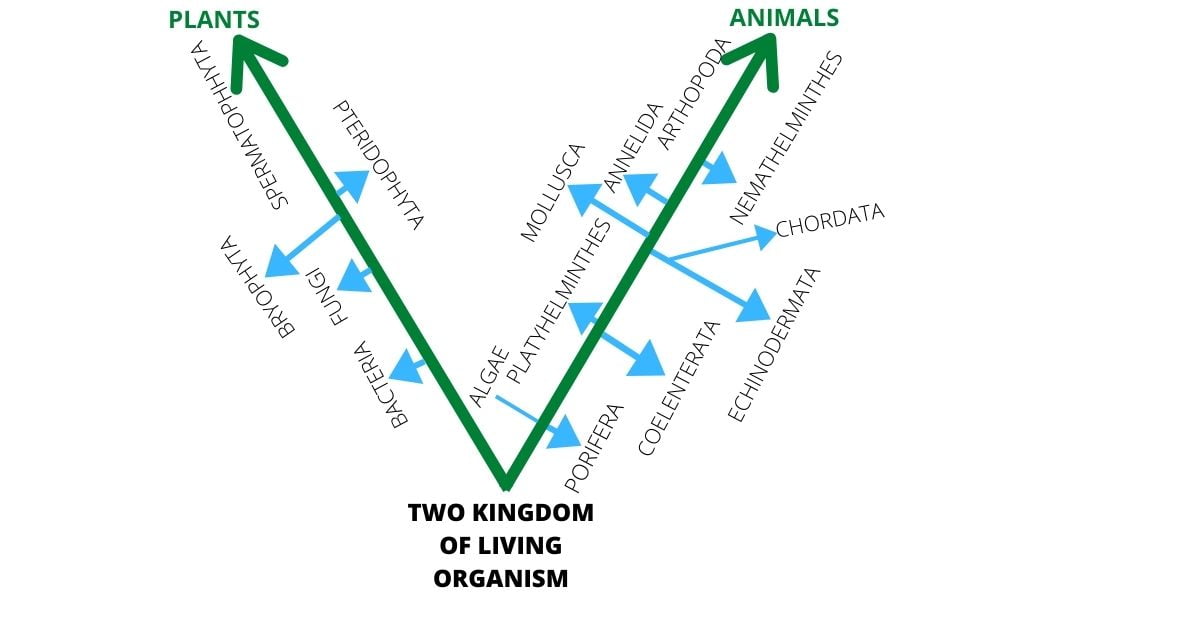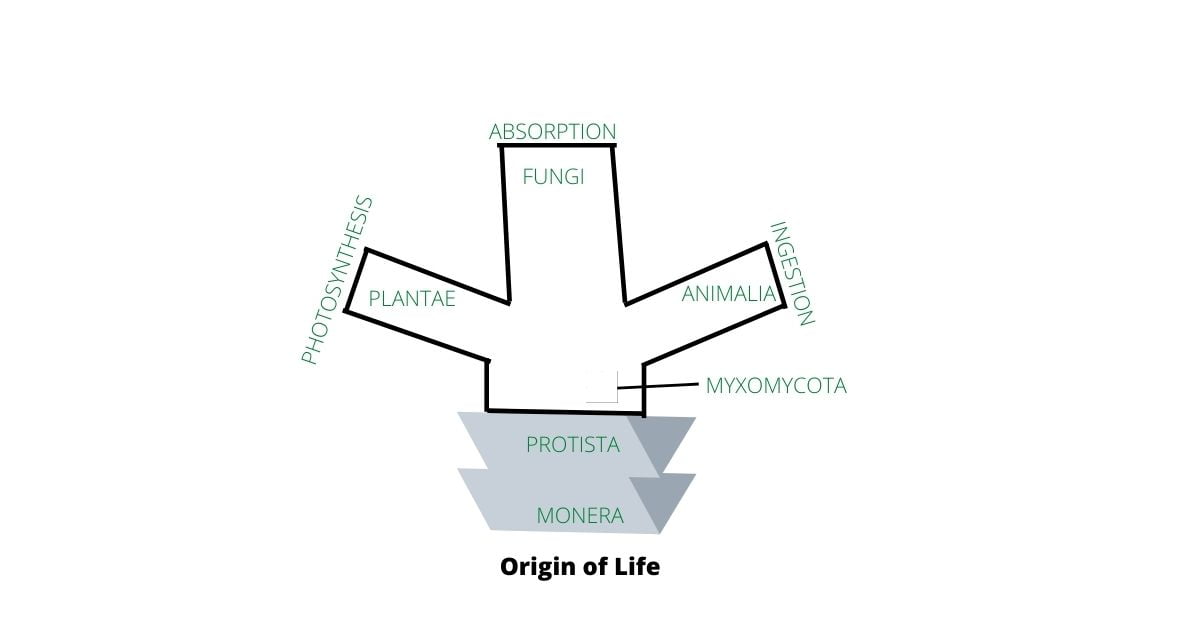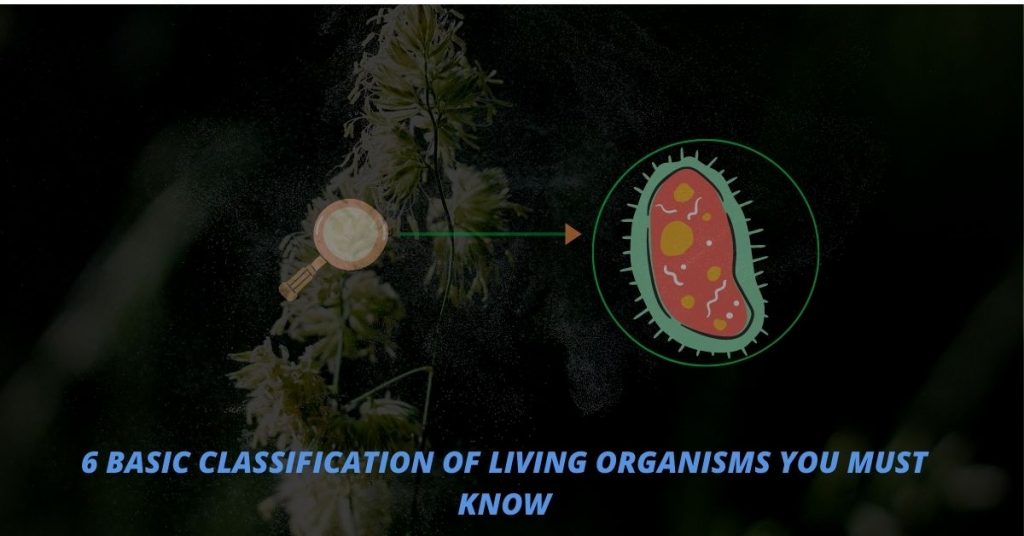Classification of living organisms is made by different scientists in different times. Each organism is different from all other organisms by a lesser or greater extent. They are identified or categorized on the basis of their body design in form and function. Some characteristics can make more wide-ranging changes in body design than others. There are also roles of time as well. So, certain body design comes into existence, it will shape the effects of all other subsequent design changes.
Classification of Living Organisms
Two kingdom system
Carolus Linnaeus, in his ‘Systema Naturae’ (1735), first distinguished living organisms into two different classifications – a) Plantae for plant kingdom and b) Animalia for the animal kingdom. He differentiates this on the basis of their nutrition and locomotion ( mobility)
- The plant is characterised by –
- Nutrition totally depends on light energy (sun).
- Presence of a rigid cell wall.
- Most of them remain rooted in soil.
- Animalia is characterised by –
- Ingestion type of food.
- Members are usually motile.
Many other Scientists placed bacteria, microscopic algae and fungi under plant kingdom because –
- They are relatively immobile.
- They are not able to ingest food.

Demerits or limitations
- This classification of living organisms did not indicate any evolutionary relationship between plants and animals.
- It combined all prokaryotes and eukaryotes.
- It also groped unicellular and multicellular organisms.
Three kingdom system
Scientists were confused after the discovery of microorganisms which have characteristics of both plants and animals. So they decided to place it in a different classification or system.
Ernest Hackel, a German zoologist in 1866 proposed third kingdom ‘ Protista’ ( Gr. Protistos – first or primitive). He includes all microscopic, unicellular, motilenon-motile and non-motile, photosynthetic or non- photosynthetic, autonomously living organisms ( neither plant nor animal). Thus all unicellular microscopic organisms of algae, fungi, protozoa and also the bacteria are included under the kingdom protista.
Scientists gave this concept as – prokaryotic, eukaryotic and protista.
- Prokaryotic (pro- primitive,karyon- nucleus) is characterised by –
- Cells have a non- membrane-bound DNA.
- semi-rigid cell wall composed of murine complex.
- Eukaryotic (Eu- true, karyon- nucleus) is characterised by –
- Cells have a well-organized nucleus.
- Well developed mitochondria and ER.
- Flagella consists of a 9+2 fibrillar organization.
- Protista characterised by –
- Lower protists a.r.e. prokaryotic protist.
- Higher protists i.e. eukaryotic protists.
Four kingdom system
Copeland(1956) proposed the fourth kingdom classification. In this system, he gave lower protists into a different kingdom, Monera. While other protists remain in the same group Protista. Thus, Four kingdoms are – Monera, Protista, Metaphyta( green plants), Metazoa( animals).
Though the four kingdom system is highly developed it suffers from several deficiencies.
Important shortcomings are –
- Lack of fundamental differences between fungi and other eukaryotic protists.
- Based on various characteristics, such as histone distribution and chromosomal organization, ecological and nutritional role etc, it is difficult to place the fungi in any one of the above kingdoms.
Five kingdom System
This division is based on what living things have in common and they differ. An American ecologist, Robert Whittaker in 1969 proposed the Five kingdom classification.
He used following criteria for classification of living organisms –
- The complexity of cell structure.
- Complexity of body organization.
- The mode of nutrition.
- Phylogenetic relationship.
The kingdoms are –
- Monera – Includes all prokaryotes and their ancestors which are unicellular. These organisms are made of a very simple cell that often lacks many organisms like nucleus.
Ex – Bacteria, blue-green algae,mycoplasma.
2.Protista – They are similar to monera in that they are unicellular but they are little complex having a nucleus. They have also moving parts which help them to move around the environment. Simply called they are unicellular eukaryotes.
Ex – Euglena, amoeba, paramecium.
- Plantae – includes multicellular eukaryotes i. e. higher algae, grass, trees. They all share common characteristics of being able to make food using water and sunlight.
Ex – Pogonatum, Dryopteris.
- Fungi – they make their own kingdom because they were once thought to be plants but differ from plants in a major way and they can’t make their own food.
Ex – Yeast, Mukor, Penicillium.
- Animalia – this is the largest kingdom and includes all multicellular animals. They can be found all over the world and can be any size from very tiny to extra large.

Six kingdom system
For the above reasons, Five kingdom classification replaced the six kingdom system. Carl Woese first proposed the system in 1977. The kingdom Monera or Prokaryotes divided into two kingdoms – Archaebacteria and Eubacteria. Other kingdoms remain the same as proposed by Whittaker.
So, six kingdoms are Archaebacteria, Eubacteria, Protista, Plantae, Fungi, Animalia.
Eight kingdom system
Cavalier-Smith proposed this eight kingdom classification of living organisms on the basis of cell structure and genetic organization. He considered ultra structural characteristics as well as rRNA sequence and other molecular characteristics. He divided the living organisms into 2 Empires i.e. Bacteria and Eukarya and 8 kingdoms.
The first empire Bacteria divided into two kingdoms –
- Eubacteria
- Archaebacteria
The second empire Eukarya divided into six kingdom –
- Archaezoa – unicellular organisms which have 70S ribosomes and devoid of Golgi apparatus, chloroplast, mitochondria, peroxisome.
Ex – Giardia etc.
- Chromista – photosynthetic organs having chloroplast within the lumen of rough E. R.
Ex – Diatoms etc.
- Protozoa
- Fungi
- Plantae
- Animalia
Summary of Kingdom Classification

How can you Classify the living organisms?
Each organism is different from all other organisms by a lesser or greater extent. They are identified or categorized on the basis of their body design in form and function.

